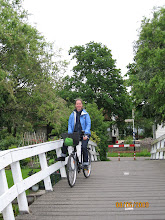Den Haag
Den Haag is the third largest Dutch city (after Amsterdam and
Rotterdam) with 500,000 (or more than a million if you include the suburbs). Riding here didn’t feel as comfortable as in
Haarlem or Utrecht. The quality of
provision was lower overall, and the traffic in some of the more multicultural
zones of the city definitely feels more hostile towards bikes and there are
fewer bikes around.
Den Haag has some separated cycleways, but
more commonly there were just bike lanes, often alongside parked cars, even where the road seemed to
have room for better.
 |
| Here the bike lane is alongside parked cars, with trams using the road too (Parkstraat) |
 |
| This bike lane is alongside poorly parked cars, though there is a massive central reservation with a park and parking on both sides of each side of the street (Nassauplein) |
 |
| The bike lane in the picture above disappears completely at this end of the street (now called Bankastraat) |
This street in the suburbs is very quiet, yet has a
bidirectional cycleway on this side, and a one way cycleway on the other side,
perhaps because there are two schools along this stretch.
 |
| Few cars on this street, but a bidirectional cycleway on this side, and ... |
 |
| ...this is the other side (Waalsdorperweg) |
As elsewhere in the Netherlands (and much of Europe?) smaller one-way streets all have contra-flow by signage or
sometimes with a lane (even just at the end, which is useful).
 |
| With contra-flow lane marked for the length of the street (Zeestraat) |
 |
| Two way for bikes, one way for cars, with no contra flow lane (Noordeinde) |
 |
| The start of the street above, with a bit of contra-flow lane to reserve space where cars turn in, and the one-way signage (bicycles excepted / uitgezondert) and only 6m wide |
 |
| Showing how the first contra flow lane terminates with give way |
The heart of the city centre is largely pedestrianised, shared
with bikes (and trams sometimes). On
narrower streets, most people seem to walk their bikes, and on the main
shopping street, a separate bicycle path is marked in the centre to separate
the bikes.
 |
| Pedestrianised area where bikes share also with tram tracks and tram stop |
 |
| Bike riders seem to mostly walk their bikes in the narrower, more crowded shopping streets |
 |
| A section of the main shopping street (Grote Marktstraat) separates bikes in the pedestrianised street, though it is necessary to watch for errant pedestrians constantly |
I was surprised to see this unusual roundabout treatment with a bike lane within the
roundabout – this puts the rider out of the sightline of entering drivers. But I guess in a lower speed environment
where drivers look carefully for bikes, maybe it works.
 |
| Unusually - a bike lane within the roundabout |
Some cycleways are alongside motorways, but so separate that
the motorway is hardly noticeable. When
crossing the motorway the bicycle lights are surprisingly quick to stop the
three lanes each way of traffic.
 |
| Along the motorway (Hubertustunnel) |
|
|
|
 |
| Quick signalised crossing (Raamweg) |
 |
| Along motorway (Raamweg) |
Heading out of town, the path goes through a wooded area,
and then onto a fairly rural looking road with fields on one side and large
houses on the other. Even on this quiet
road with barely a car, there is a separate path.
 |
| Through the woods |
 |
| Remote, with few cars, but still a separated cycleway |
Two nice features of Den Haag:
 |
| Grassy tram tracks |
 |
| The Den Haag Hilton - bikes available for guests :o) |


























0 Comments:
Post a Comment
Subscribe to Post Comments [Atom]
<< Home